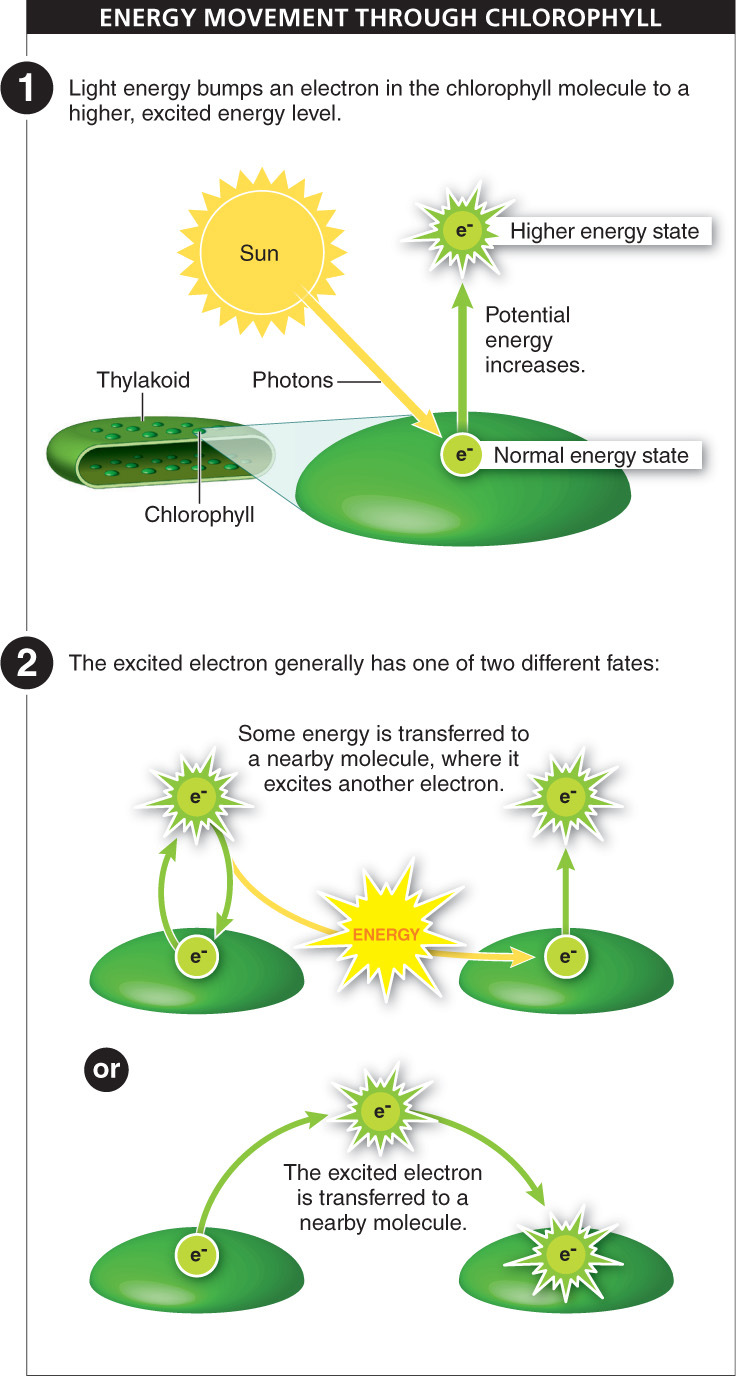An organism can use energy from the sun only if it can convert the light energy of the sun into the chemical energy in the bonds between atoms. The most important molecule in this conversion is the pigment chlorophyll (FIGURE 4-16). When chlorophyll is hit by photons of certain wavelengths, the light energy bumps an electron (e–) in the chlorophyll molecule to a higher energy level, an excited state. Upon absorbing the photon, the electron briefly gains energy, and the potential energy in the chlorophyll molecule increases.

An electron in a photosynthetic pigment that is excited to a higher energy state generally has one of two fates. (1) The electron returns to its resting, unexcited state, releasing energy in the process, some of which may bump electrons in a nearby molecule to a higher energy state (while the rest of the energy is dissipated as heat). Or (2) the excited electron itself is passed to another molecule.
The passing of electrons from molecule to molecule is one of the chief ways that energy moves through cells. Many molecules carry or accept electrons during cellular activities. All that is required is that the acceptor must have a greater attraction for electrons than does the molecule from which it receives them. This receiver molecule, in turn, hands off electrons to another acceptor with an even greater attraction for them. A molecule that gains electrons always carries greater energy than it did before receiving the electron(s). For this reason, the passing of electrons from one molecule to another can be viewed as a passing of potential energy. In this way, energy moves through cells.
This transfer of electrons is one of the first steps of photosynthesis, the process that enables a plant to harness light energy from the sun and convert it to the more readily usable chemical energy. As we see later in this chapter, the dismantling of food molecules such as glucose to generate energy is also a story of breaking and rearranging chemical bonds as electrons pass from one atom or molecule to another.
Suppose a large meteor hit the earth. How could smoke and soot in the atmosphere wipe out life far beyond the area of direct impact?
Because particles in the atmosphere can block light from the sun and reduce the excitation of electrons in chlorophyll molecules, photosynthesis depends on a relatively clean atmosphere. Any reduction in the available sunlight can have serious effects on plants. Scientists believe that if a large meteor hit the earth—
149
TAKE-HOME MESSAGE 4.8
When chlorophyll is hit by photons, the light energy excites an electron in the chlorophyll molecule, increasing the chlorophyll’s potential energy. The excited electrons can be passed to other molecules, moving the potential energy through the cell.
What are the two possible fates of an excited electron in a chlorophyll molecule?
The excited electron may release energy while returning to its resting state, with some of this released energy used to excite electrons in a nearby molecule. Alternately, this excited electron itself could be transferred to another molecule.